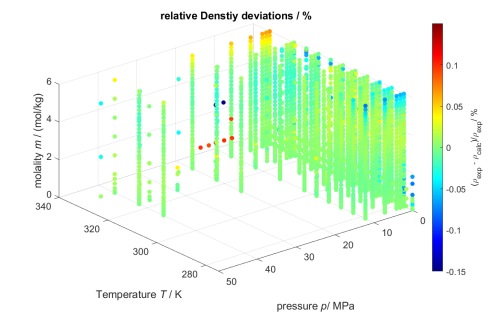In energy and process engineering, the calculation of state variables for fluids plays an important role. Since the steady increase in computer capacities, highly accurate fundamental equations formulated explicitly in the Helmholtz energy wherever state variables are required with a very high degree of accuracy became the standard. The calculation of mixtures of a wide variety of substances is also a large and important area of thermodynamics. In recent years, the Chair of Thermodynamics has dealt with both highly accurate pure fluid and mixture equations of state (GERG-2008 [1], internationally recognized standard for natural gases and natural gas components).
In the calculation of properties of mixtures, problems often arise in which two-phase equilibria of gas and liquid have to be calculated. In GERG-2008 [1], an algorithm for the calculation of phase equilibria is implemented, which allows the calculation of gas-liquid equilibria in a stable manner and with very good results. However, in the context of the planned capture and storage of CO2, more complex phase equilibria, such as liquid-liquid, solid-liquid, or solid-gas equilibria, may occur due to pipeline transport of CO2 contaminated with other substances. Algorithms for calculating three-phase equilibria are also needed.
The aim of this project is to develop computational algorithms of complex phase equilibria, including phase equilibria with solid phases. For this purpose, a fundamental equation for dry ice is developed. In addition, for the CO2 / water system, a hydrate phase can also occur in addition to the solid phases of water and CO2.
Storage sites for the CO2-rich mixtures are often saline aquifers. The thermodynamic properties of the brines in the aquifers are very different from those of pure water. To enable safe and economic storage of CO2 in saline aquifers, existing solute data models must be extended to account for the influence of salts. Salts have a strong influence on the amount of dissolved gases in the liquid phase and their density, requiring models to accurately describe the interaction of combustion gases with saline water. Calculations with pure water would lead to overestimates of the potential amount of CO2 that can be stored, as well as the impurities resulting from capture.

To ensure consistent calculations within the entire CCS process chain with the previously developed equations of EOS-CG-2016 [2] and EOS-CG-2019 [3], as well as for solids including storage in saline aquifers, a model for hydrous salts (brines) formulated in the Gibbs energy and a model for CO2-rich fluids, explicit in the Helmholtz energy, are combined.
The brine is represented by the IAWPS equation for seawater [5], which is the international standard for seawater properties and is valid over a wide range of salinities. It is formulated in terms of the Gibbs energy with the independent variables of temperature, pressure, and absolute salinity. The CO2-rich fluids are represented by the EOS-CG-2019 [3] model, which is currently the most accurate model for describing combustion gases. These equations are explicitly formulated in the Helmholtz energy with the independent variables of temperature, density, and composition.
In order to be able to describe more flexible pressure and temperature ranges, as well as higher salinities with the model for brines, parameters are adjusted in a model based on Pitzer's equations [4]. This model is also combined with the highly accurate equations of state so that it can be used for modeling sequestration processes in saline aquifers.
[1] Kunz, O.; Wagner, W., J. Chem. Eng. Data, 2012, 57:3032
[2] J. Gernert, R. Span, J. Chem. Thermodyn. 93, 274-293, 2016
[3] S. Herrig, New Helmholtz-Energy Equations of State for Pure Fluids and CCS-Relevant Mixtures, Dissertation, Ruhr-Universität Bochum, 2018.
[4] Pitzer, K.S.; Activity Coefficients in Electrolyte Solutions, 2nd Edition; CRC Press, 1991
[5] International Association for the Properties of Water and Steam, Release on the IAPWS Formulation 2008 for the Thermodynamic Properties of Seawater, (2008).